Thermal imaging technology is a technology that converts thermal signals into visual images by detecting infrared thermal radiation emitted by objects. It has a wide range of important application scenarios in optical instruments. The following is a classification explanation from different fields:
I. Industry and manufacturing
1. Equipment fault detection and maintenance
Application scenarios: power system (transformer, cable connector overheating detection), machinery manufacturing industry (bearing wear, motor overload heating monitoring), chemical pipeline (temperature anomaly investigation caused by leakage or blockage).
Instrument type: handheld thermal imager, online thermal imaging monitoring system.
Advantage: non-contact detection, which can quickly locate hidden dangers without interrupting production and avoid downtime losses.
2. Production process optimization
Application scenarios: metal processing (welding temperature field monitoring, heat treatment uniformity analysis), semiconductor manufacturing (chip thermal distribution detection, packaging process defect location), 3D printing (layer-by-layer temperature control to optimize molding quality).
Instrument type: high-precision thermal imaging camera, infrared thermal imager integrated into the production line detection system.
2. Security and monitoring
1. Night surveillance and hidden target detection
Application scenarios: border monitoring (detection of illegal crossing of stowaways or wild animals), urban security (tracking of suspicious persons at night), forest firefighting (early warning of fire heat sources).
Instrument type: thermal imaging night vision device, thermal imaging network camera.
Advantages: not limited by lighting conditions, can penetrate smoke and light fog, and has a long detection distance (up to several kilometers).
2. Perimeter protection and intrusion alarm
Application scenarios: intrusion detection in sensitive areas such as airports, prisons, and military bases, using thermal imaging sensors to identify the heat signals of people or vehicles and trigger alarms.
Instrument type: thermal imaging intelligent analysis system (combined with AI algorithms to distinguish between humans, animals and interference sources).
3. Medical and health fields
1. Disease auxiliary diagnosis
Application scenarios: dermatology (vascular abnormalities, early thermal characteristics analysis of tumors), pain medicine (abnormal body temperature detection of muscle strain or neuropathy), and visualization of traditional Chinese medicine (meridian thermal imaging to evaluate blood circulation).
Instrument type: medical infrared thermal imager (must comply with medical device certification).
Note: Currently, it is mainly used as an auxiliary means and needs to be combined with clinical diagnosis.
2. Scientific research and biomedical research
Application scenarios: animal behavior (monitoring of nighttime activity patterns), cell culture (temperature uniformity detection of constant temperature chambers), drug development (thermal stability testing).
Instrument type: microscopic thermal imaging system (combined with a microscope to observe temperature changes of tiny samples).
IV. Construction and energy industry
1. Building energy-saving detection
Application scenarios: wall/roof insulation performance evaluation (thermal bridge effect positioning), door and window air tightness detection (temperature loss caused by air leakage), floor heating pipe leakage investigation.
Instrument type: building-specific thermal imager (equipped with analysis software to generate heat loss reports).
2. Monitoring of new energy facilities
Application scenarios: photovoltaic power stations (hot spot effect detection of solar panels, judgment of component failure), wind turbines (gearbox, bearing temperature monitoring), energy storage power stations (battery pack thermal runaway warning).
Instrument type: UAV equipped with thermal imager (realize large-area rapid inspection).
V. Outdoor and Public Safety
1. Search and Rescue
Application scenarios: Searching for trapped people in disasters such as earthquakes and fires (penetrating smoke to detect human heat sources), searching and rescuing lost people in the wild (locating heat signals at night or in complex terrain).
Instrument type: portable thermal imager, helicopter/drone-mounted thermal imaging search and rescue system.
2. Wildlife Protection
Application scenarios: Night animal population monitoring (avoiding visible light from interfering with animal behavior), illegal poaching prevention (thermal imaging cameras monitor protected areas in real time).
Note: Wildlife protection regulations must be followed and illegal hunting is prohibited.
VI. Aerospace and Defense
1. Aircraft Detection and Guidance
Application scenarios: Aircraft engine heat distribution monitoring (fault warning), missile guidance (infrared imaging seeker locks on target heat source), satellite thermal control system testing (temperature field analysis in space environment).
Instrument type: high-precision thermal imager, infrared radiation calibration equipment.
2. Military reconnaissance and night vision
Application scenarios: single-soldier combat (thermal imaging night vision device to identify enemy personnel and equipment), armored vehicle fire control system (thermal imaging sight to achieve all-weather combat).
Technical features: Military-grade thermal imagers usually have higher sensitivity, anti-interference ability and concealment.
VII. Scientific research and laboratory scenarios
1. Material science research
Application scenarios: new batteries (heat diffusion monitoring during charging and discharging), nanomaterials (heat conductivity characteristics analysis), phase change materials (temperature field recording during state change).
Instrument type: high-resolution thermal imaging microscope, transient thermal imaging system (capturing rapid temperature changes).
2. Meteorological and environmental monitoring
Application scenarios: volcanic activity monitoring (magma heat flow tracking), glacier ablation research (temperature gradient analysis), urban heat island effect assessment.
Instrument type: satellite-mounted thermal imaging sensors (such as MODIS thermal infrared channel), ground-based meteorological station thermal imaging equipment.
Core advantages of thermal imaging technology
Non-contact: no need to directly contact the target, suitable for high temperature, high pressure, and dangerous environments.
All-weather capability: not limited by visible light, can work in darkness, haze, and smoke.
Real-time and visualization: quickly generate thermal images, intuitively display temperature distribution, and facilitate data analysis.
If you need to know the specific instrument model or technical parameters (such as temperature measurement range, resolution), please further explain your needs!


